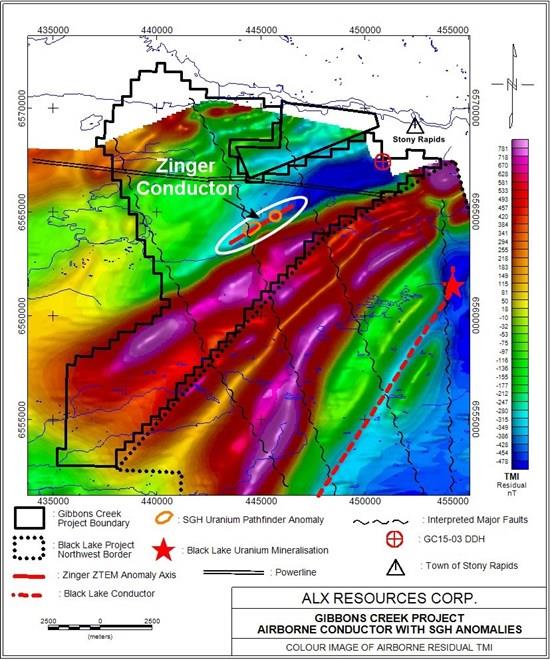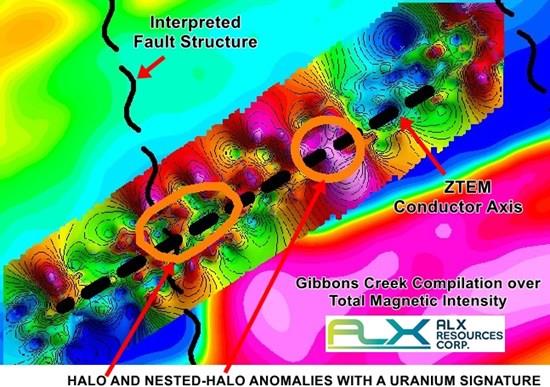(MENAFN- Newsfile Corp) ALX Resources Corp. Defines Drill Targets at Gibbons Creek Uranium Project, SK
Vancouver, British Columbia--(Newsfile Corp. - December 15, 2021) - ALX Resources Corp. (TSXV: AL) (FSE: 6LLN) (OTC: ALXEF) ('ALX' or the 'Company') is pleased to announce that it has received the results of a geochemical survey carried out on its 100%-owned Gibbons Creek Uranium Project ('Gibbons Creek', or the 'Project'). Gibbons Creek consists of seven mineral claims encompassing 13,864 hectares (34,259 acres), located along the northern margin of the Athabasca Basin immediately west of the community of Stony Rapids, Saskatchewan, in a region hosting multiple uranium occurrences.
2021 Exploration Results
In October 2021, ALX carried out a Spatiotemporal Geochemical Hydrocarbons ('SGH') soil geochemistry survey on a 4.0-kilometre-long grid over an untested geophysical conductor to determine the most prospective areas for drilling. SGH is an analytical method developed by Actlabs of Ancaster, Ontario that is designed to detect subtle geochemical anomalies emanating from a buried source.
The SGH survey results show the haloes of uranium pathfinder anomalies over two areas of the 'Zinger' airborne conductor. The two anomalies are proximal to the intersection of the conductor with an interpreted NNW-trending fault structure that cross-cuts the NE-SW strike of the Zinger conductor, thus providing a compelling series of drill targets.

Gibbins Creek Project Airborne Conductor With SGH Anomalies
To view an enhanced version of this graphic, please visit:

2021 SGH Survey Results with Airborne Conductor Axis and Interpreted Fault Structure
To view an enhanced version of this graphic, please visit:
In June 2021, ALX received an exploration permit for Gibbons Creek, good to October 2022, that allows for a 5,000-metre drilling program in up to 20 holes along with ground-based geophysics, prospecting and geochemical sampling. Access to the Project is year-round, thereby creating a flexibility for either summer or winter exploration programs. Drilling is anticipated to begin in early 2022 following further engagement with First Nations and other local communities.
To view maps and photos of Gibbons Creek click here
Uranium Showings in the Northern Athabasca Basin
- Nisto Mine : Located approximately 30 kilometres east from the centre of Gibbons Creek. Mining first occurred at the Nisto Mine in 1950-51. In 1959, Haymac Mines restarted mining and shipped 500 tons of high-graded ore to the Lorado Mill at Uranium City, SK. One shipment of 106 tons of ore graded 1.6% U3O8 (Source: Saskatchewan Mineral Deposits Index, Mineral Property #1621).
- Black Lake Uranium Project ('Black Lake'): Located adjacent to Gibbons Creek. Owned 40% by ALX, with UEX Corporation ('UEX') holding a 51.426% interest and Orano Canada Inc. holding an 8.574% interest. Following the discovery of uranium mineralization in 1998 by Uranerz Exploration and Mining, UEX intersected 0.69% U3O8 over 4.4 metres in 2004 drill hole BL-18, which led to over a decade of follow-up exploration, including 142 additional drill holes. Multiple mineralized intersections were encountered at Black Lake along a graphitic fault system since the uranium discovery in hole BL-18 (see ALX news release dated July 31, 2017 ).
- Fond du Lac Uranium Deposit : Located approximately 70 kilometres west of the Project near the south shore of Lake Athabasca. The Fond du Lac uranium deposit was discovered in 1970 by Camok Ltd., a predecessor company of Orano Canada Ltd. after tracing radioactive boulders to their source area and grid drilling. A shallow, historical resource was calculated in 1970 by Camok Ltd. of 990,000 pounds (450,000 kilograms) at an average grade of 0.25% of U3O8 but was never advanced further (Source: Saskatchewan Mineral Deposits Index, Mineral Property #1572. This historical resource is not compliant with the standards of National Instrument 43-101, has not been verified by ALX's Qualified Person and is included for information purposes only.)
About Gibbons Creek
The Project is complemented by the infrastructure provided at Stony Rapids, SK, including all-weather Highway 905, a commercial airport, equipment rentals and supplies, as well as readily available accommodation, therefore providing high efficiencies for exploration. Exploration by ALX and its predecessor company Lakeland Resources Ltd. has discovered the following indicators of uranium mineralization:
- Prospecting in 2013 confirmed the presence of high-grade uranium-bearing boulders ranging up to 4.28% U3O8;
- Radon surveys in 2015 detected an anomaly approximately 1,200 metres by 500 metres in size with peak radon values ranging between 4.00 picocuries per square metre per second ('pCi/m2/sec') and 10.77 pCi/m2/sec at ten locations, which are among the highest recorded radon values in the Athabasca Basin;
- Historical drill hole GC15-03 intersected 0.13% U3O8 over 0.23 metres, within a 1.1 metre interval of 333.8 parts per million uranium, immediately below the sub-Athabasca unconformity;
- Spectroscopic analysis of core samples from ALX's 2015 drilling detected clay alteration products such as illite and sudoite (a unique form of chlorite associated with uranium mineralization) in the sandstone at or near the unconformity, which suggests that hydrothermal alteration has occurred in the vicinity of the drill hole;
- Geophysical conductors defined by a 2017 airborne ZTEM survey remain to be tested;
- In 2020, ALX carried out surface prospecting on the Star Gold and PGE showing in the northern part of the Project and collected grab samples from outcrop ranging up to 3.58 grams/tonne gold, 122 parts per billion ('ppb') platinum and 412 ppb palladium.
NationaI Instrument 43-101 Disclosure
The technical information in this news release has been reviewed and approved by Jody Dahrouge, P.Geo., a Director of ALX, who is a Qualified Person in accordance with the Canadian regulatory requirements set out in National Instrument 43-101.
Soil samples described in this news release were analyzed by the SGH method developed by Activation Laboratories Ltd. (Actlabs) in Ancaster, Ontario. Upon receipt, samples are air-dried and then sieved with the -80 mesh sieve fraction collected. From the collected pulp, compounds are separated by gas chromatography and detected by mass spectrometry at a reporting limit of one part per trillion.
Geochemical results for surface samples collected by ALX in 2020 were analyzed at the Saskatchewan Research Council in Saskatoon, SK by Inductively Coupled Plasma Mass Spectrometry (ICP-MS). Gold, platinum and palladium were analyzed by fire assay techniques.
Historical geochemical results and geological descriptions quoted in this news release were taken directly from assessment work filings and summary reports published by the Government of Saskatchewan. Management cautions that historical results were collected and reported by past operators and have not been verified nor confirmed by its Qualified Person, but create a scientific basis for ongoing work in the Gibbons Creek area. Management further cautions that past results or discoveries on adjacent or nearby mineral properties are not necessarily indicative of the results that may be achieved on ALX's mineral properties.
About ALX
ALX is based in Vancouver, BC, Canada and its common shares are listed on the TSX Venture Exchange under the symbol 'AL', on the Frankfurt Stock Exchange under the symbol '6LLN' and in the United States OTC market under the symbol 'ALXEF'.
ALX's mandate is to provide shareholders with multiple opportunities for discovery by exploring a portfolio of prospective mineral properties, which include uranium, nickel-copper-cobalt and gold projects. The Company uses the latest exploration technologies and holds interests in over 250,000 hectares of prospective lands in Saskatchewan, a stable Canadian jurisdiction that hosts the highest-grade uranium mines in the world, a producing gold mine, and production from base metals mines, both current and historical.
ALX holds interests in a number of uranium exploration properties in northern Saskatchewan, including a 20% interest in the Hook-Carter Uranium Project , located within the uranium-rich Patterson Lake Corridor with Denison Mines Corp. (80% interest) operating exploration since 2016, a 40% interest in the Black Lake Uranium Project (a joint venture with UEX Corporation and Orano Canada Inc.), and 100% interests in the Gibbons Creek Uranium Project , the Sabre Uranium Project and the Javelin and McKenzie Lake Uranium Projects .
ALX also owns 100% interests in the Firebird Nickel Project (now under option to Rio Tinto Exploration Canada Inc., who can earn up to an 80% interest), the Flying Vee Nickel/Gold and Sceptre Gold projects, and can earn up to an 80% interest in the Alligator Lake Gold Project, all located in northern Saskatchewan, Canada. ALX owns, or can earn, up to 100% interests in the Electra Nickel Project and the Cannon Copper Project located in historic mining districts of Ontario, Canada, the Vixen Gold Project (now under option to First Mining Gold Corp., who can earn up to a 100% interest from ALX in two stages), and in the Draco VMS Project in Norway.
For more information about the Company, please visit the ALX corporate website at or contact Roger Leschuk, Manager, Corporate Communications at: PH: 604.629.0293 or Toll-Free: 866.629.8368 , or by email:
On Behalf of the Board of Directors of ALX Resources Corp.
'Warren Stanyer'
Warren Stanyer, CEO and Chairman
FORWARD-LOOKING STATEMENTS
Statements in this document which are not purely historical are forward-looking statements, including any statements regarding beliefs, plans, expectations or intentions regarding the future. Forward-looking statements in this news release include: the Gibbons Creek Project ('Gibbons Creek') is prospective for uranium, gold, and PGE mineralization; the Company's plans to undertake exploration activities at Gibbons Creek, and expend funds on Gibbons Creek. It is important to note that the Company's actual business outcomes and exploration results could differ materially from those in such forward-looking statements. Risks and uncertainties include that ALX may not be able to fully finance exploration at Gibbons Creek, including drilling; our initial findings at Gibbons Creek may prove to be unworthy of further expenditure; commodity prices may not support exploration expenditures at Gibbons Creek; exploration programs may be delayed or changed due to consultation and engagement with certain First Nations and the results of such consultations; and economic, competitive, governmental, societal, public health, environmental and technological factors may affect the Company's operations, markets, products and share price. Even if we explore and develop Gibbons Creek, and even if uranium or other metals or minerals are discovered in quantity, the project may not be commercially viable. Additional risk factors are discussed in the Company's Management Discussion and Analysis for the Nine Months Ended September 30, 2021, which is available under the Company's SEDAR profile at Except as required by law, we will not update these forward-looking statement risk factors.
Neither the TSX Venture Exchange nor its Regulation Services Provider (as that term is defined in the policies of the TSX Venture Exchange) accepts responsibility for the adequacy or accuracy of this release
To view the source version of this press release, please visit
MENAFN15122021004218003983ID1103367308